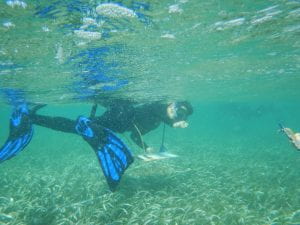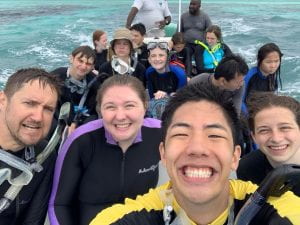Hi!
Today was better. Communicating with my buddies is still hard, my mask keeps fogging, and some water inevitably always getting caught in my snorkel, but maneuvering is a little easier in the deeper water. Yesterday I was getting really frustrated trying to stand in one place with my feet anchored to the ground, but today I just had to kick a little and float in the same place (the same place being sort of relative).
Also, remember how before I left Houston I said I wanted to learn how to use a quadrat effectively? We’re definitely working on that here at Glover’s. We spent the morning using line transects and quadrats to measure coral skeletons from rocks/other things at a coral graveyard on the other side of the island (yay stability on land). Then in the afternoon we took our transect tape and quadrats out to a seagrass bed and measured seagrass vs algae vs other things in the ocean. We counted all the things under the crosshairs of the quadrat (the places where the strings intersect). I thought writing on the clipboard or staying still enough to count would be the hardest part, but actually the hardest part was getting our transect tape to stay in place in the sand.

After measuring the seagrass beds we got to swim out to a patch reef for a little bit (keep in mind it took us nearly 2 hours to do the measuring, now we’re voluntarily in the water longer to see these reefs). At the patch reef I saw my mollusc of the day: a Queen Conch (Stombus gigas). At least I think it was a Queen Conch based on shell size/shape. Usually you would also use shell color pattern to help identify the mollusc, but this guy’s shell was completely colonized by algae so I couldn’t see if it was the characteristic orange/pink.

Tomorrow we’re taking our quadrats to the next level: measuring a patch reef!
-Kelsey
